Why you can trust Tom's Hardware
Comparison Products
We compare the 1TB Patriot Viper VPR400 to the Patriot P400 and HP FX900, two drives that have the same type of hardware. We also include the Silicon Power UD90, which uses a rival Phison E21T controller. The WD Black SN770 is also included because it is a strong competitor in this segment. Lastly, we have three high-end drives: the SK hynix Platinum P41, the Samsung 980 Pro, and the Crucial P5 Plus. As usual, we test all drives at the same capacity.
Trace Testing - 3DMark Storage Benchmark
Built for gamers, 3DMark’s Storage Benchmark focuses on real-world gaming performance. Each round in this benchmark stresses storage based on gaming activities including loading games, saving progress, installing game files, and recording gameplay video streams.


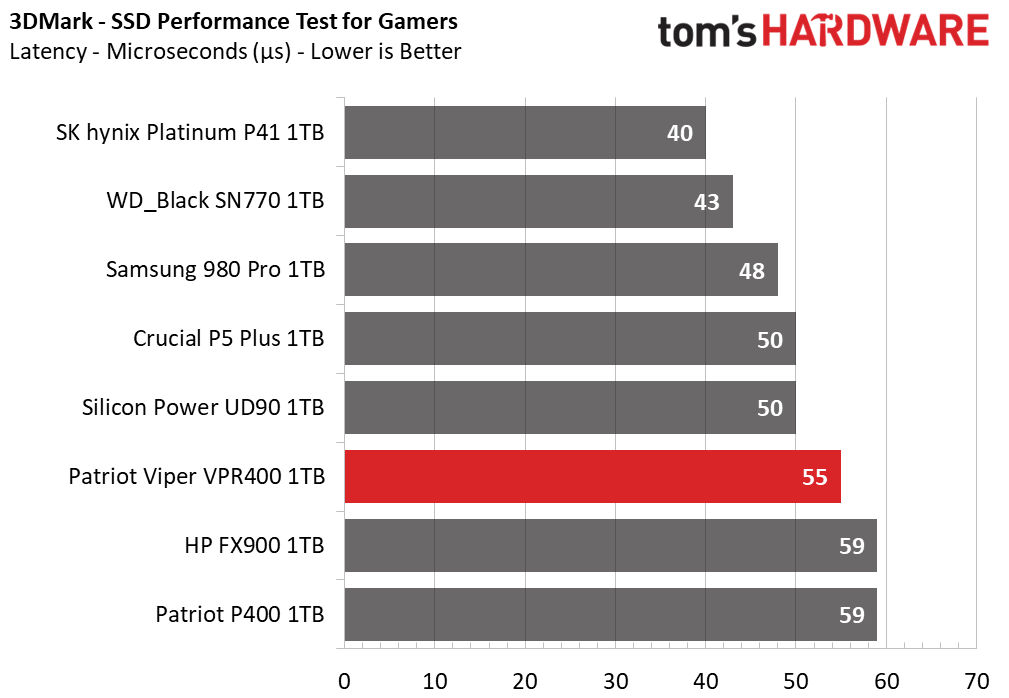
The VPR400 actually seems to do better than its two direct peers in this test. It falls behind the rest, but its performance is still adequate.
Trace Testing – PCMark 10 Storage Benchmark
PCMark 10 is a trace-based benchmark that uses a wide-ranging set of real-world traces from popular applications and everyday tasks to measure the performance of storage devices.


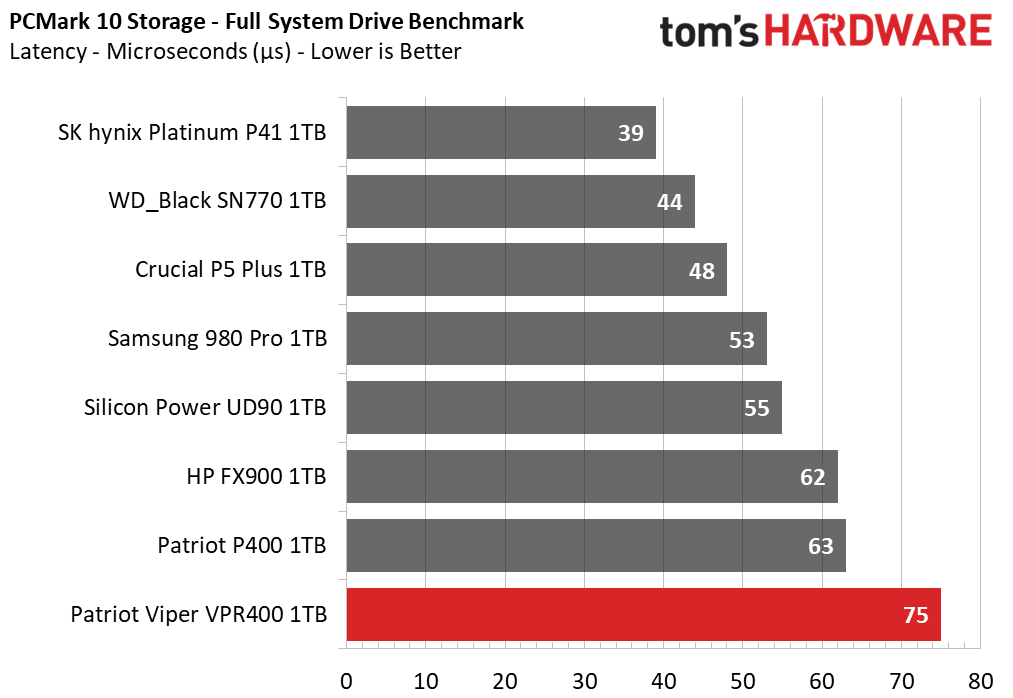
In contrast to the 3DMark results above, the VPR400 comes in dead last in PCMark. The differences in these tests may be down to optimization or firmware, particularly as the VPR400 is specifically designed for gaming.
Transfer Rates – DiskBench
We use the DiskBench storage benchmarking tool to test file transfer performance with a custom, 50GB dataset. We copy 31,227 files of various types, such as pictures, PDFs, and videos to a new folder and then follow-up with a reading test of a newly-written 6.5GB zip file.


The VPR400 lands exactly where we’d expect it to in this bandwidth-limited test: right in the middle. It performs well against its direct competitors, including the UD90 and SN770.
Get Tom's Hardware's best news and in-depth reviews, straight to your inbox.
Synthetic Testing - ATTO / CrystalDiskMark
ATTO and CrystalDiskMark (CDM) are free and easy-to-use storage benchmarking tools that SSD vendors commonly use to assign performance specifications to their products. Both of these tools give us insight into how each device handles different file sizes.












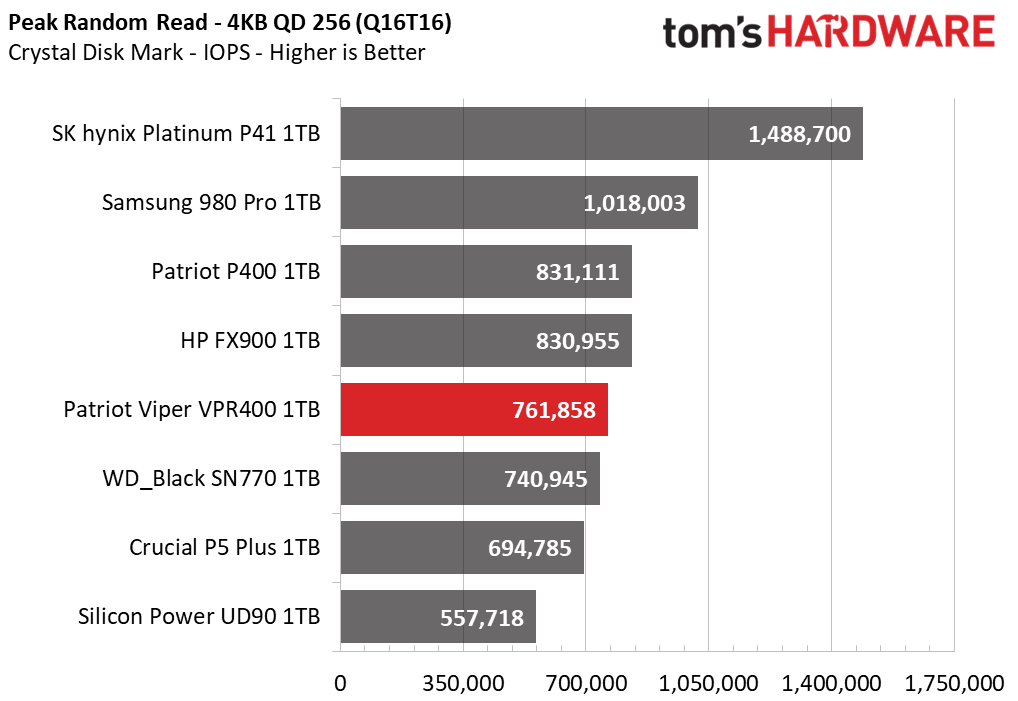
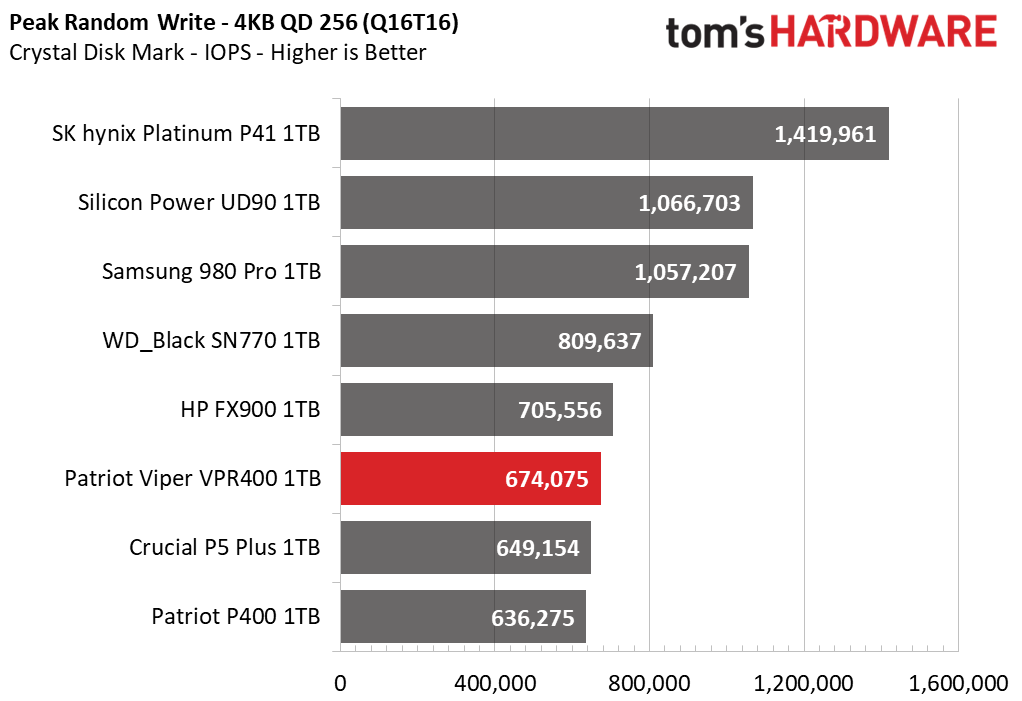
There are no surprises with the ATTO tests — the VPR400 matches the P400. It’s also a fair match for the SN770. What we do see is the UD90 pulling away in sequential read performance, a Phison staple that indicates the E21T SSD controller has a shared lineage with the popular E18.
The VPR400's sequential performance is also solid in CrystalDiskMark. Performance in random workloads lags a little bit, particularly with writes, but reads tend to be more important, and these results are good on the whole. This hardware combination - controller and flash - has proven itself to be consistently above par. Nevertheless, the SN770 and UD90 remain competitive.
Sustained Write Performance and Cache Recovery
Official write specifications are only part of the performance picture. Most SSDs implement a write cache, which is a fast area of (usually) pseudo-SLC programmed flash that absorbs incoming data. Sustained write speeds can suffer tremendously once the workload spills outside of the cache and into the "native" TLC or QLC flash. We use Iometer to hammer the SSD with sequential writes for 15 minutes to measure both the size of the write cache and performance after the cache is saturated. We also monitor cache recovery via multiple idle rounds.
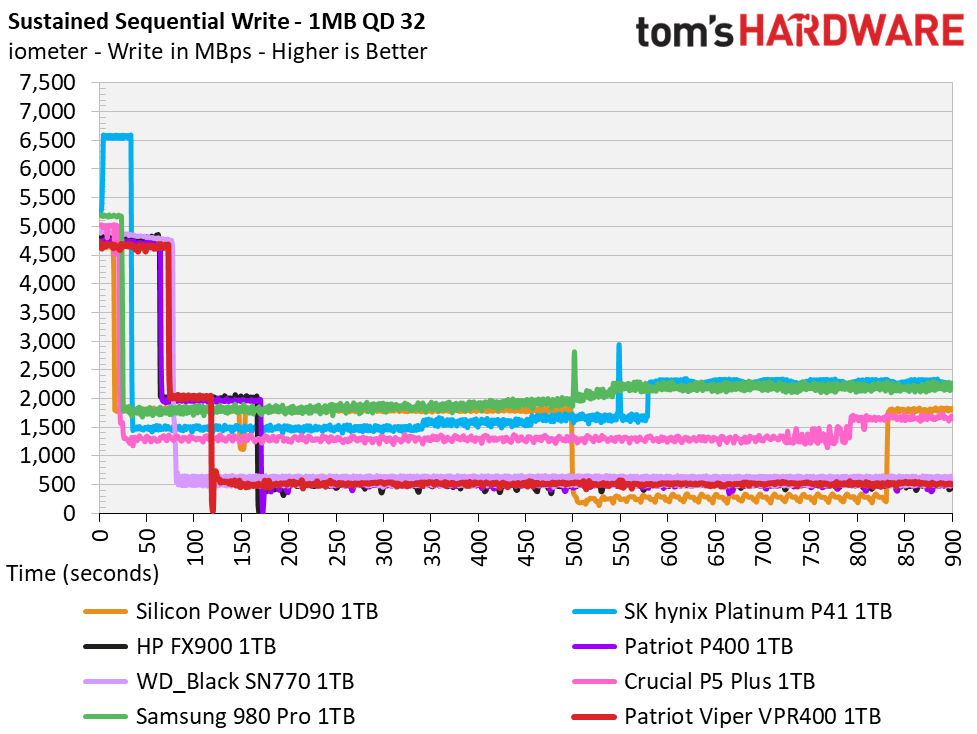




The VPR400 has three distinct performance states with SLC, TLC, and folding modes. The primary mode of pseudo-SLC writes at 4.65 GBps for up to 73 seconds, indicating an SLC cache of around 340GB. This is a bit larger than what is found on the FX900 and P400. Its TLC state at 2 GBps is correspondingly much shorter before hitting the 500 MBps bottleneck.
The VPR400 is clearly optimized a bit differently than those two peers, although the difference would not usually be noticeable in practice. This flash is quite fast in its native state, which makes for relatively quick writes for a four-channel controller. In addition, the large SLC cache should catch most things even if the drive is fuller. That being said, the SN770 matches it quite well, while the UD90 would be more consistent.
Power Consumption and Temperature
We use the Quarch HD Programmable Power Module to gain a deeper understanding of power characteristics. Idle power consumption is an important aspect to consider, especially if you're looking for a laptop upgrade as even the best ultrabooks can have mediocre storage.
Some SSDs can consume watts of power at idle while better-suited ones sip just milliwatts. Average workload power consumption and max consumption are two other aspects of power consumption, but performance-per-watt is more important. A drive might consume more power during any given workload, but accomplishing a task faster allows the drive to drop into an idle state more quickly, ultimately saving energy.
We also monitor the drive’s temperature via the S.M.A.R.T. data and an IR thermometer to see when (or if) thermal throttling kicks in and how it impacts performance. Remember that results will vary based on the workload and ambient air temperature.



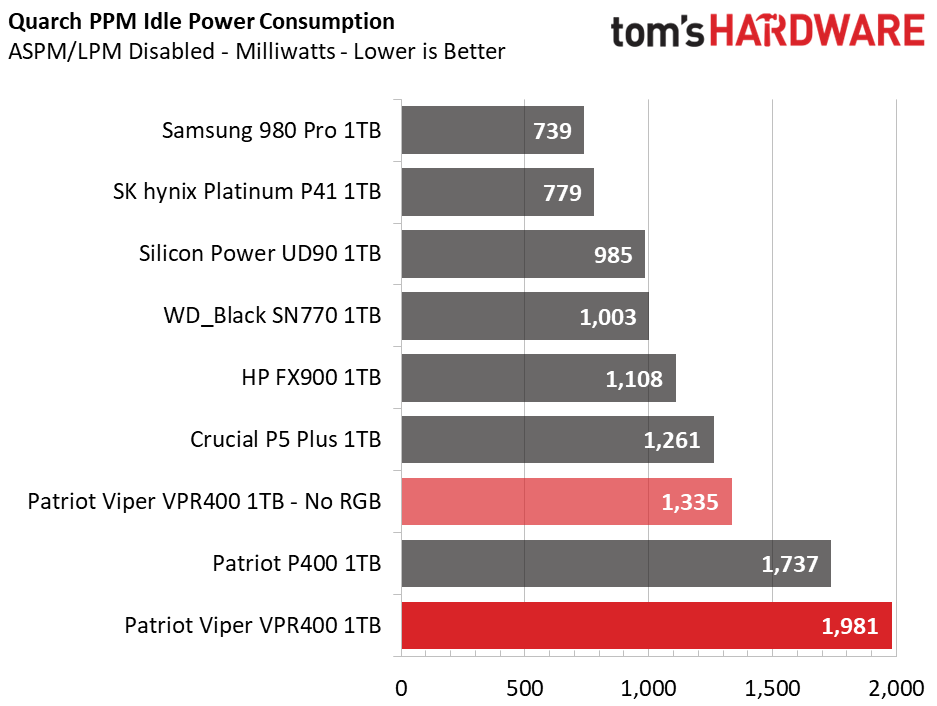
We’ve charted the VPR400’s power consumption both with and without the LEDs illuminated. Unsurprisingly, the drive is more efficient without the LEDs enabled. As expected, it comes close to the P400 in that state, rivaling the SN770. However, the drive consumes significantly more power with the RGB enabled, although this is probably not a concern with use in a desktop PC.
We also tested thermals under both conditions. With RGB disabled, the drive idled around 50C with a maximum of around 69C after an extreme amount of writes; no throttling was seen even after 600GB. With RGB enabled, the idle temperature rose to the mid-50s Celsius, hitting over 73C with sustained writes. This was sufficient to engage throttling after about 420GB of writing. So we can say that the heatsink does work and helps compensate for the extra LED heat sufficiently for its intended use.
Test Bench and Testing Notes
| CPU | Intel Core i9-11900K |
| Motherboard | ASRock Z590 Taichi |
| Memory | 2x8GB Kingston HyperX Predator DDR4 5333 |
| Graphics | Intel UHD Graphics 750 |
| CPU Cooling | Alphacool Eissturm Hurricane Copper 45 3x140mm |
| Case | Streacom BC1 Open Benchtable |
| Power Supply | Corsair SF750 Platinum |
| OS Storage | WD_Black SN850 2TB |
| Operating System | Windows 10 Pro 64-bit 20H2 |
We use a Rocket Lake platform with most background applications such as indexing, windows updates, and anti-virus disabled in the OS to reduce run-to-run variability. Each SSD is prefilled to 50% capacity and tested as a secondary device. Unless noted, we use active cooling for all SSDs.
Conclusion
The Patriot VPR400 is essentially more of a good thing, serving as a Patriot P400 with a better warranty, a heatsink, and RGB. The RGB lighting syncs with most major platforms with Patriot’s software, as well. The InnoGrit IG5220 is a proven SSD controller and Micron’s 176-layer TLC remains the best flash on the market. What’s not to love?
Part of the problem is that this market segment is becoming crowded and competitive. There are other drives with the same hardware, sure, but also WD’s stellar SN770. Moreover, we have newcomers like Silicon Power’s UD90, which uses Phison’s new E21T controller, nipping at the heels. The VPR400 certainly stands out with its looks and the performance is nothing to ignore. However, it doesn’t really do anything new.
Patriot says a 2TB SKU is forthcoming, which would be nice as we don’t see that with the P400 or HP’s FX900 (yet), but it's still missing at the time of writing. That’s okay as 1TB is the sweet spot with this type of drive, but then we have to start looking at the price. The VPR400, as priced today on Amazon, is simply far too expensive unless you absolutely need matching RGB for your build. We do appreciate the heatsink and metal heat spreader, but ultimately it’s not a lot more effective than plain drives with the same hardware.
If you’re looking for a budget drive or even an entry-level PCIe 4.0 SSD, this is simply not the drive for you. It’s more along the lines of the Lexar SL660 Blaze, a portable drive with RGB, in the sense that it’s aimed at the gamer aesthetic. Patriot does separate the VPR400 a bit from its own P400 with a better warranty, but similar drives like the FX900 plus ADATA’s Legend 840 and Atom 50 already do that at a competitive price. That’s not to mention the SN770, which for the average gamer, assuming they don’t care about RGB, is a safer bet.
MORE: Best SSDs
MORE: How We Test HDDs And SSDs
MORE: All SSD Content

Shane Downing is a Freelance Reviewer for Tom’s Hardware US, covering consumer storage hardware.
-
WrongRookie So how is it that viper gets to do the RGB but the others that are the better drives don't? Even Asus new SSD isn't having RGB atleast from the image itself...Reply
Not sure about it being expensive considering even the p41 itself is priced a bit at 1tb.
